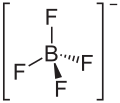Lithium tetrafluoroborate
|
|
|||
| Names | |||
|---|---|---|---|
|
IUPAC name
Lithium tetrafluoroborate
|
|||
| Other names
Borate(1-), tetrafluoro-, lithium
|
|||
| Identifiers | |||
|
14283-07-9 |
|||
| 3D model (Jmol) | Interactive image | ||
| ChemSpider |
3504162 |
||
| ECHA InfoCard | 100.034.692 | ||
| PubChem | 4298216 | ||
|
|||
|
|||
| Properties | |||
| LiBF4 | |||
| Molar mass | 93.746 g/mol | ||
| Appearance | White/grey crystalline solid | ||
| Odor | odorless | ||
| Density | 0.852 g/cm3 solid | ||
| Melting point | 296.5 °C (565.7 °F; 569.6 K) | ||
| Boiling point | decomposes | ||
| Very soluble | |||
| Hazards | |||
| Main hazards | Harmful, causes burns, hygroscopic. |
||
| Safety data sheet | External MSDS | ||
| NFPA 704 | |||
| Related compounds | |||
|
Other anions
|
Tetrafluoroborate, | ||
|
Related compounds
|
Nitrosyl tetrafluoroborate | ||
|
Except where otherwise noted, data are given for materials in their standard state (at 25 °C [77 °F], 100 kPa).
|
|||
|
|
|||
| Infobox references | |||
Lithium tetrafluoroborate is an inorganic compound with the formula LiBF4. It is a white crystalline powder. It has been extensively tested for use in commercial secondary batteries, an application that exploits its high solubility in nonpolar solvents.
Although BF4− has high ionic mobility, solutions of its Li+ salt are less conductive than other less associated salts. As an electrolyte in Lithium-ion batteries, LiBF4 offers some advantages relative to the more common LiPF6. It exhibits greater thermal stability and moisture tolerance. For example, LiBF4 can tolerate a moisture content up to 620 ppm at room temperature whereas LiPF6 readily hydrolyzes into toxic POF3 and HF gases, often destroying the battery's electrode materials. Disadvantages of the electrolyte include a relatively low conductivity and difficulties forming a stable solid electrolyte interface with graphite electrodes.
Because LiBF4 and other alkali-metal salts thermally decompose to evolve boron trifluoride, the salt is commonly used as a convenient source of the chemical at the laboratory scale:
LiBF4 is a byproduct in the industrial synthesis of diborane:
LiBF4 can also be synthesized from LiF and BF3 in an appropriate solvent that is resistant to fluorination by BF3 (e.g. HF, BrF3, or liquified SO2):
...
Wikipedia


